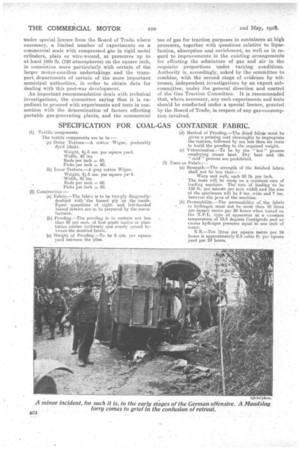SPECIFICATION FOR COAL-GAS CONTAINER FABRIC.
Page 12

If you've noticed an error in this article please click here to report it so we can fix it.
(1) Textile components.
The textile components are to be , (a) Outer Texture.—A cotton. Wigan, preferably • dyed khaki.
Weight, 4-5 ozs. per sqiiare yard. Width, 42 ins.
Ends per inch = 60.
Picks per inch • 60, (b) Inner-Texture.—A grey cotton Wigan. Weight, 41-5 ozs. per square ya.7.40 Width,•42 Ends per inch 60.
-Picks per inch = 60.
(2) Construction
(a) Fabric.—The fabric is to be two-ply diagonallydoubled With-the biased ply on the inside. Equal quantities of rightand left-handed biased fabrics are to be prepared by the manu
facturer. • • (b) Proofing.—The proofing is to contain not less than 90 per -cent. of first grade native or plantation rubber uniformly and evenly spread between the doubled fabric.
(c) Weight of Piroofing.—To be 6 can per square yard between the plies.. (d) Method of Proofing.—The dried fabric must be given a priming coat thoroughly to impregnate the texture, followed by not less than six coats to build the proofing to the required weight. (e) Vulcanizatien.—T6 be by the "hot" process employing steam heat. Dry heat and Uri. " cold " process are prohibited.
(3) Tests on Fabric :— (a) Strength.—The strength of the finished fabric shall not be. less than :— Warp and weft, each 60 lb. per inch. The tests will be made on a constant rate of loading machine. The tate, 'of loading to be 150 lb. per minute per inch width and the size of the specimens Will be 2 ins, wide and 7 ins. between the jaws of the machine.
(b) Permeability.—The permeability of the fabric to hydrogen must riot he more than 10 litres per square metre per 24 hourS when tested on the N.P.L. type of apparatus at a constant temperature of 15:5 degrees Centigrade and an excess hydrogen pressure equal to one inch of water.• N.B.—Ten litres per square metre per 24. hours is approximately 0.3 cubic ft. per square yard per 24 houra.






















